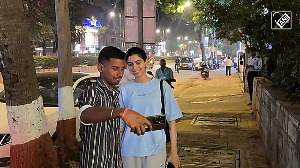Even as 10-lakh odd voters in Goa prepare to elect a new 40-member Assembly on Saturday, the vital question remains whether the election will end instability in the politically volatile state.
Post-1990, Goa has failed to get a stable government with few chief ministers lasting for less than a year.
Congress' Ravi Naik created a history of sorts by becoming the shortest serving chief minister for seven days in 1994.
A quick look at the tourist state's history shows that it ventured into political instability only after it attained statehood in 1987 and number of constituencies increased from 30 to 40.
Since then most of the elections threw up fractured verdict, allowing politicians to switch sides.
Goa, an erstwhile Portuguese colony, was liberated in 1961 but the first democratic election for Union Territory of Goa, Daman and Diu was held only in 1963.
That year two regional parties, Maharashtrawadi Gomantak Party and United Goans, fought a bitter poll battle across the state with the former winning majority of seats.
Dayanand Bandodkar was elected as Goa's first chief minister, who remained in power for next ten years before being succeeded by his daughter Shashikala Kakodkar after his death.
Kakodkar, who became chief minister in 1973, remained in power till 1979.
Till 1979, Goa was ruled by regional parties. It was only in 1980 that for the first time Congress ruled the state under the leadership of Pratapsingh Rane, who went on to become five-time chief minister of the tiny state.
Actual decline of regional outfits in Goa began when national parties cemented their presence in the state.
The Congress won one seat in 1963, did not contest 1967 election, and remained on just one seat in 1972 election.
It was the fifth Assembly poll on January 3, 1980 with hardly 5.2 lakh voters that threw up a new trend in voting pattern. The voters delivered a crushing blow to the supremacy of regional parties.
They changed the course of Goan politics, which saw the arrival of the Congress in a big way with Rane taking over as the chief minister.
In 1984, the trend continued with electorate ruling in favour of the Congress.
The regional parties' hold had diminished with once dominant MGP getting only eight seats.
The MGP, however, came back strongly and managed to increase its hold in 1989 but fell short of a majority. It formed an alliance with BJP in 1994 election, spelling doom for itself.
The 1994 poll saw BJP making its maiden appearance in the Assembly but could not form the government.
In 1999, BJP went alone and bagged 10 seats while MGP was confined to mere four seats. Congress again formed the government.
The scene changed in last elections in 2002 which saw BJP getting 17 seats and Congress 16.
As no party got an absolute majority, the smaller parties joined hands with BJP, which formed its first government under the leadership of Manohar Parrikar, an IIT graduate-turned-politician.
The Parrikar government was pulled down in 2005 by a few MLAs who switched their loyalty to the Congress.
This election, Congress and NCP have forged an alliance while rest of the parties are going on their own.
jMGP is trying to revive its sagging fortunes, while Save Goa Front, a new party, is seeking to make a difference.





